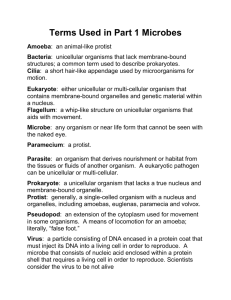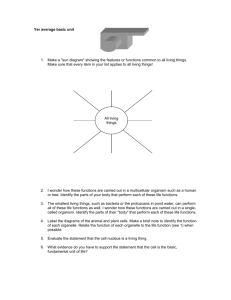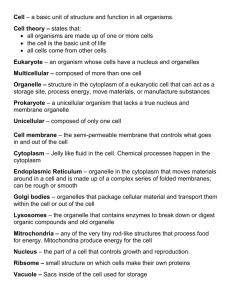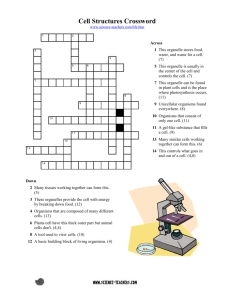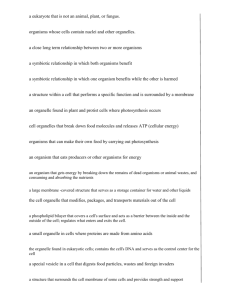Cell - swofford8
advertisement
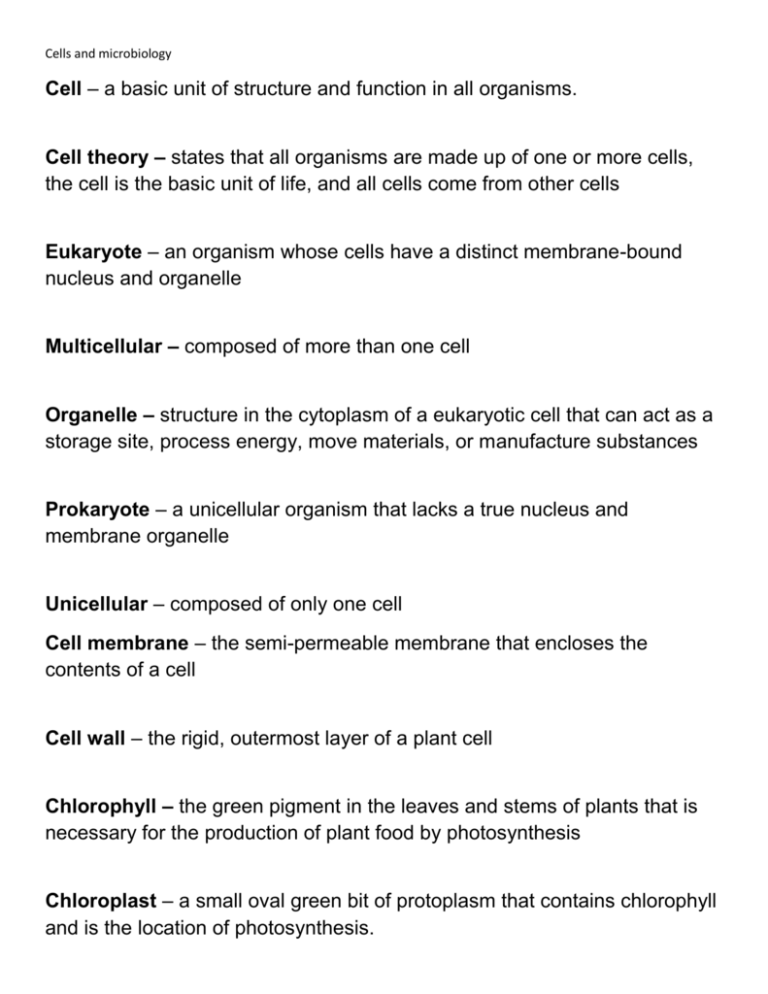
Cells and microbiology Cell – a basic unit of structure and function in all organisms. Cell theory – states that all organisms are made up of one or more cells, the cell is the basic unit of life, and all cells come from other cells Eukaryote – an organism whose cells have a distinct membrane-bound nucleus and organelle Multicellular – composed of more than one cell Organelle – structure in the cytoplasm of a eukaryotic cell that can act as a storage site, process energy, move materials, or manufacture substances Prokaryote – a unicellular organism that lacks a true nucleus and membrane organelle Unicellular – composed of only one cell Cell membrane – the semi-permeable membrane that encloses the contents of a cell Cell wall – the rigid, outermost layer of a plant cell Chlorophyll – the green pigment in the leaves and stems of plants that is necessary for the production of plant food by photosynthesis Chloroplast – a small oval green bit of protoplasm that contains chlorophyll and is the location of photosynthesis. Cytoplasm – inherited genetic material in a cell not specified by its own nucleus. Endoplasmic reticulum – organelle in the cytoplasm that moves materials around in a cell and is made up of a complex series of folded membranes; can be rough or smooth Golgi bodies – organelles that package cellular material and transport them within the cell or out of the cell Lysosomes – the organelle that contains enzymes to break down or digest organic compounds and old organelle Mitrochondria – any of the very tiny rod-like or string-like structures that occur in nearly all cells of plants and animals, and that process food for energy Nucleolus – a small spherical body in the nucleus of a cell, consisting of protein and RNA. Nucleus – the part of a cell that controls growth and reproduction. Ribsome – small structure on which cells make their own proteins Vacuole – a membranous enclosure within a cell that contains substances Amoeba: an animal-like protist Bacteria: unicellular organisms that lack membrane-bound structures; a common term used to describe prokaryotes.. Cilia: a short hair-like appendage used by microorganisms for motion. Eukaryote: either unicellular or multi-cellular organism that contains membrane-bound organelles and genetic material within a nucleus. Eyespot: an organelle of the protist euglena that is sensitive to light. Flagellum: a whip-like structure on unicellular organisms that aids with movement. Microbe: any organism or near life form that cannot be seen with the naked eye. Paramecium: a protist. Parasite: an organism that derives nourishment or habitat from the tissues or fluids of another organism. A eukaryotic pathogen can be unicellular or multi-cellular. Prokaryote: a unicellular organism that lacks a true nucleus and membrane-bound organelle. Protist: generally, a single-celled organism with a nucleus and organelles, including amoebas, euglenas, paramecia and volvox. Pseudopod: an extension of the cytoplasm used for movement in some organisms. A means of locomotion for an amoeba; literally, “false foot.” Virus: a particle consisting of DNA encased in a protein coat that must inject its DNA into a living cell in order to reproduce. A microbe that consists of nucleic acid enclosed within a protein shell that requires a living cell in order to reproduce. Scientists consider the virus to be not alive. Active immunity: protection against a disease acquired by being infected with the pathogen that causes the disease. Amoebic dysentery: a disease that is caused by a parasite. The protist amoeba that is found in contaminated food and water. Antibiotic: a group of medicines used to kill or slow the growth of bacteria that cause disease. Antibody: a chemical substance made by the body to help destroy an invading pathogen. Antimicrobial product: is a substance that is designed to kill microbes before they enter the body. Carrier: a person with a disease that they can pass on to other organisms. Contagion: an infectious disease that can be transmitted or spread from one organism to another. Disease: is any change that disrupts the normal function of one or more body systems. Epidemic: a disease that spreads over a wide geographic area. Infectious disease: any disease that is caused by a pathogen. Influenza: an acute, commonly epidemic disease, occurring in several forms, caused by numerous rapidly mutating viral strains and characterized by respiratory symptoms. Noninfectious disease: a disease that cannot be spread from one organism to another. Pathogen: a microbe that causes disease in an organism. Polio: an acute viral disease marked by inflammation of nerve cells of the brain stem and spinal cord. Small pox: is an infectious disease unique to humans, caused by either of two virus: variants named Variola major and Variola minor. Vaccine: any preparation used as a preventive inoculation to confer immunity against a specific disease, usually employing an innocuous form of the disease agent, as killed or weakened bacteria or viruses, to stimulate antibody production. Vector: an animal that carries and transmits a disease. Biotechnology: industrial use of living organisms, or parts of living organisms to produce foods, drugs, or other products. DNA: is the nucleic acid responsible for carrying the genetic information of most organisms from one generation to the next. Mutagen: a toxic chemical that causes damage to an organism’s DNA. Mutation: a random change to a gene that results in a new trait. RNA: is the nucleic acid used by most organisms for protein synthesis.
